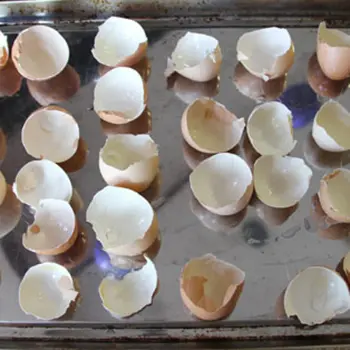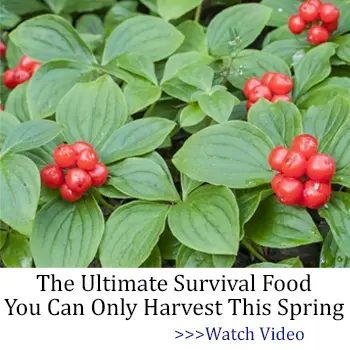When planting tomatoes, it seems that everyone has a preferred niche or requirement for them. Some people say to plant them in the furthest west corner of your garden to really give them that early morning sunlight, which they do seem to love. Others will tell you that you have to tarp them (or plant them in moisture-wicking potting soil) to avoid them getting too wet. I personally disagree with that bit, but those in drenched areas like Seattle may find their tomatoes floating away during heavy downpours.
What most of us agree on is that tomatoes desperately need all the calcium they can get. And what is almost pure calcium? Something that a great deal of us break every morning?
Eggshells.
Today we’ll look at how you can most effectively use eggshells to give your calcium-starved tomatoes the nutrition that they need. Let’s get started.
Calcium? Or So Much More?
Let’s start at the beginning: the chicken makes that egg.
Grocery store eggs, the ones that come from birds that are kept “battery” style, will not have the same nutritional profile that a free-range, pastured egg will. For simplicity’s sake, we are using chicken eggs in this article but it applies to ducks, turkeys, and any other eggs you might want to use. You will have a more diverse, healthy shell (and egg!) full of more nutrients if the chicken laying the egg is allowed to be a chicken, not just an egg-producing blob in a cage.
As of this writing, the price gap between pastured eggs and battery eggs really isn’t that deep. In my area, pastured, free-range eggs are about $6.50 per 18 eggs. The price of battery eggs? $4.28 (at Wal-Mart). For another couple of dollars, your eggshells will be more valuable to your garden. If you can afford it, get the more expensive eggs.
A pastured, free-range egg is made up of mostly calcium. However, these shells also offer beneficial nutrients such as magnesium, copper, and so much else. If all you can get your hands on is battery eggs, use them; but be aware that they will have much lower amounts of these trace nutrients that mean so much to your tomatoes.
Easiest Way For Tomatoes To Uptake Eggshells
Like everything else in this world, you’ll be working to help your tomatoes make the most out of their eggshells. Isn’t that the way it always goes?
We’ll get into exactly how to do this down below, but a powdered eggshell or a very finely crushed one is the best source of eggshell for your tomato plant. The big thing here is to make it easy for the tomato to use the eggshell as thoroughly as it can.
If at all possible, please try to mix the eggshells in with your potting soil. If your tomato plant gets heavily watered by rain or flood, add a little extra top dressing of powdered eggshell to your soil. Calcium not only helps the plant regulate how much water is in its system, but it also helps to draw the moisture away and prevent tomatoes from getting so wet that they fade.
Prepwork and How-To
Perhaps you’re already experiencing blossom-end rot and really want to get to work. Well, we’re here for you. And that.
Keep your eggshells from breakfast (or any other meal of the day) in a Ziploc bag in the fridge for up to 1 week after cracking. It does not matter if they end up crushed or if they are mostly whole.
When you have a week’s worth, go ahead and turn on your oven to 350 degrees. Line a baking sheet with a piece of parchment paper and put your eggshells on it. If you have especially gross or goopy ones, you may want to rinse these off. You don’t have to, but it does prevent sticking after this next step.
Place your eggshells in the oven and bake until the eggshells are fully dried out (usually 20-30 minutes though this can depend somewhat on local humidity and your personal oven). When dried, remove them from the oven and allow them to cool.
Related: What Happens If You Plant An Egg In Your Garden
To make these eggshells as fine as possible, I’ve invested in a cheap ($10) coffee grinder. A few quick blitzes and there’s nothing left but a fine powder that is perfect and ready for the garden. Food processors will also do the job, but be aware that they may leave the edges a little sharper than a coffee bean grinder will. Most of them are, after all, made for chopping, not grinding, and the difference here is important.
This powder is shelf-stable for up to 10 years but be aware that you will likely go through it much sooner than you think you will. A tablespoon should be more than enough for most tomato plants, but you can’t really scorch them or overdose with eggshells. They simply won’t absorb the excess calcium and will allow the growth to use it the next year or the year after that.
Please keep your calcium in a dark, cool storage area. A pantry is a perfect spot to keep your jar. Exposure to light can discolor the powder and cause excess moisture to bead.
A Few Final Thoughts
Pelletized calcium is available at most garden centers, but why waste your money on that when you can use something that you are literally throwing away? Plus, some pelletized calcium is not pet (and other animal) safe. Baked, ground eggshells should be completely safe for all but animals suffering from kidney failure; and then only if they eat the entire bottle (as I’m sure most pet parents who are working with a kidney failure pet are aware of). Once mixed into the soil, eggshells are harmless to the rest of the world at large.
Have you used eggshells for your tomato plants or other nightshades? How has it worked out for you? We’d love to hear about your experience in the comments down below. Drop us a line and remember, Happy Gardening!
You may also like:
What Happens When You Pour Sugar Into An Onion? (Video)
50 Off the Grid Homesteading Tips and Tricks
















